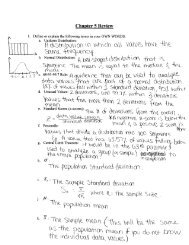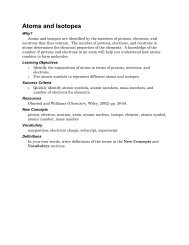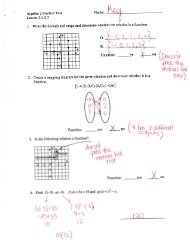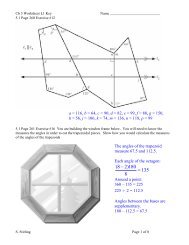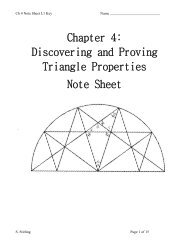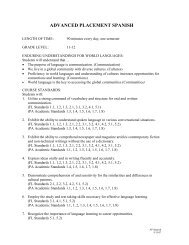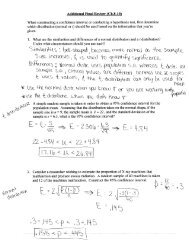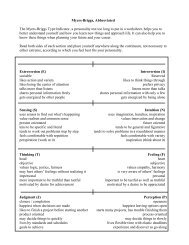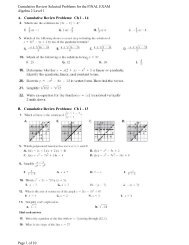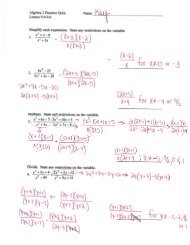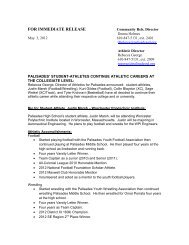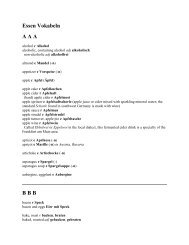Answer Key
Answer Key
Answer Key
You also want an ePaper? Increase the reach of your titles
YUMPU automatically turns print PDFs into web optimized ePapers that Google loves.
F’orm WS6. 3. IA Name<br />
PHASES OF’ MATTER Date Period<br />
a<br />
Heating a substance in a given phase generally causes the temperature to<br />
increase. This causes the particles to move faster and collide harder. Harder,<br />
faster collisions cause particles to rebound harder moving them further apart.<br />
Larger distances between particles weakens the forces of attraction between<br />
them. When the forces ofattraction are weak enough, the distance between the<br />
particles increases markedly and the phase changes. As a result, a solid melts<br />
and a liquid evaporates. The reverse happens when a substance cools. As the<br />
particles slow down and the collisions weaken, the particles move closer<br />
together increasing the forces of attraction between the particles. As a result,<br />
a gas condenses and a liquid freezes. At normal atmospheric pressures, some<br />
substances change directly from a solid to a gas. This change is called<br />
sublimation. This is what occurs when ice cubes shrink in the freezer, or when<br />
a wash dries on a clothesline on a cold winter day. Some substances, such as<br />
dry ice never pass through a liquid phase at standard pressure<br />
[101.3 kPaJ. A gas can also change directly to a solid. This is called deposition.<br />
[C0<br />
2(s)j,<br />
<strong>Answer</strong> the questions below based on your reading and on your knowledge of chemistry.<br />
1. In the space below are the labels solid, liquid, and gas. Draw arrows between them to represent phase changes. Label each<br />
arrow with the name of the phase change it represents. Two examples are done for you. Also, draw an arrow labeled<br />
temperature to show the direction in which temperature is increasing.<br />
Solid as<br />
Liquid<br />
Melting<br />
2. Under what conditions does a solid melt<br />
fL<br />
9 Why?I.<br />
e<br />
y<br />
(fpe4)<br />
3/t>J ‘//<br />
d-cj<br />
1i iib ,f<br />
3. Under what conditions does gas conden ? Why?<br />
/‘/e 1J<br />
Ui’k Cf<br />
(Continued<br />
I’)
nLt,rf: Form WS6, 3. 1A Phase Changes<br />
PHASES OF MATTER Page 2<br />
4. Why do substances change phase as the temperature changes? Refer to the distance between particles and the force of<br />
attraction between them in your answer. f Le_ pci’ k _,<br />
/ L fh., ,ti, f/r(/,Vt<br />
aJ eh% — •,—<br />
o<br />
i t ..<br />
5. To the right is a graph showing the relationship between temperature, pressure,<br />
and phase for a substance. <strong>Answer</strong> the questions below based on the graph.<br />
a. Draw a dotted line going across the graph at a pressure where sublimation<br />
could occur. Label it “a.”<br />
0 Liquid<br />
b. Draw a solid line going across the graph at a pressure where melting and<br />
vaporization could occur. Label it “b.”<br />
c. Under normal conditions, carbon dioxide gas turns directly into a solid as<br />
it is cooled. What could be done to make carbon dioxide form a liquid? -<br />
(kj<br />
tJ<br />
I<br />
6. Under normal conditions, butane is a gas. In butane lighters, the gas is put under pressure and it forms a liquid. Explain<br />
)<br />
why a gas liquefies under pressure even with Ut cooling it. Ottir —<br />
o r//io’<br />
/<br />
7. What would happen to a liquid at a constant temperature as the pressure is reduced? Why? t<br />
b0:I i N<br />
1rvL jj’ / P 3’-k 1ff / ‘C<br />
8.<br />
© Evan P. Silberstein, 2003<br />
)
nii’f: Form WS6,3.313 Name<br />
PHASES OF MATTER Date Period<br />
Vajr rrsur’<br />
An open glass of water left standing around will eventually evaporate even with out<br />
being heated. When water evaporates, it changes from a liquid to a gas called water<br />
vapor. Water vapor takes up more space than an equal mass of liquid water. As a<br />
result, in a closed container, the vapor that forms can exert a significant amount of<br />
pressure. This pressure is known as vapor pressure. Even in an open container, the<br />
vapor is confined by the air pressing down on it. Some of it collects at the surface<br />
and exerts pressure, Occasional high energy molecules at the water’s surface escape.<br />
That is why the water eventually evaporates. But for a water to expand arid form<br />
vapor bubbles throughout the liquid as it does when it boils, the vapor has to exert<br />
as much pressure as the blanket of air confining it. As a liquid is heated, more of it<br />
turns into vapor, and the vapor pressure increases. When the vapor pressure reaches<br />
atmospheric pressure, the liquid boils. Under greater external pressure, the liquid<br />
boils at a higher temperature.<br />
Let me ou<br />
The graph below shows the vapor pressures of four common liquids as a function of temperature. Refer to the graph<br />
to answer the questions that follow.<br />
1.?<br />
7)14<br />
I ‘4<br />
(O<br />
€4<br />
1. Which ofthe substances above has<br />
the lowest boiling point?<br />
2. Which ofthe substances above has<br />
boilingpointof l0O°C9<br />
3. Which ofthe substances above has<br />
the highest boiling point?<br />
On<br />
— 4. Which ofthe substances above has<br />
the highest vapor pressure at<br />
40°C?<br />
e 5. Which of the substances above<br />
6Z6.<br />
6<br />
I I [€4<br />
7.<br />
ri’.<br />
€4<br />
will boil at 79°C?<br />
At what temperature will alcohol<br />
boil when the atmospheric<br />
pressure is 50 kPa?<br />
At what atmospheric pressure will<br />
propanone boil at 20°C?<br />
At what atmospheric pressure will water boil at 90°C?<br />
Which of the substances above has the lowest vapor pressure at 70°C?<br />
What is the vapor pressure of water at 60°C?<br />
I<br />
}<br />
‘<br />
4fVI<br />
:<br />
Vapor Pressur of Four Uqulds<br />
: :: : ::<br />
-<br />
2’<br />
,,<br />
7<br />
25 50 15<br />
mmo.rtu. •c<br />
Il I I<br />
e<br />
- - -<br />
lid<br />
I<br />
1<br />
4-<br />
I<br />
1<br />
i:<br />
at<br />
d<br />
-<br />
100 125<br />
10. As the pressure decreases, the boiling point of water (a) increases, (b) decreases, (c) remains the same.<br />
f<br />
© Evan P. Silberstein, 2003
irvq: Form WS6.3.2A Name<br />
PHASES OF MATTER Date Period<br />
Curv<br />
As a substance is heated, its particles begin to move faster and spread<br />
apart. The speed of the particles is related to their kinetic energy. The<br />
relative position of the particles is related to their potential energy. As<br />
solids, liquids, and gases are heated, most of the energy that is absorbed<br />
is converted to kinetic energy, and the temperature goes up. But as a<br />
substance melts or vaporizes, its particles spread out tremendously. As<br />
a result, the energy absorbed produces changes in the potential energy<br />
of the particles, so the temperature does not change as the phase<br />
changes. For that reason, the freezing point and the melting point of a<br />
substance are the same.<br />
Base your answers to the following questions on the graph below<br />
which shows 10.0 kg of a substance that is solid at 0°C and is heated<br />
at a constant rate of 60 kilojoules per minute.<br />
2.<br />
L—J. 3.<br />
5W K<br />
/t/f°1(T 6.<br />
7.<br />
What is the temperature at which the<br />
substance can be both in the solid and<br />
the liquid phase?<br />
During which lettered intervals is the<br />
internal potential energy of the<br />
substance increasing?<br />
During which lettered intervals is the<br />
kinetic energy of the particles<br />
increasing?<br />
How much heat is added to the<br />
substance from the time it stops<br />
melting to the time that it begins to<br />
boil?<br />
What is the total heat needed to melt the substance (starting at time 0)?<br />
What is the total heat needed to vaporize the substance (starting at time 0)?<br />
What is the heat of vaporization of the substance?<br />
‘4- B 8. During which lettered intervals is the substance solid?<br />
2 9. During which lettered intervals is the substance in the liquid phase?<br />
10. During which lettered intervals is the substance in the vapor phase?<br />
I<br />
0<br />
1iOt ii.<br />
0°C = 0°C<br />
14U<br />
:80 EZEEEE7EEZEEE<br />
6O————<br />
-<br />
0 4 8 12<br />
. Time<br />
16<br />
in minutes<br />
, )(;<br />
2<br />
/ 1 ‘/ 0<br />
What is the temperature at which the substance can be both in the liquid and the vapor phase?<br />
20 24<br />
© Evan P. Silberstein, 2003
-<br />
?tr(:<br />
Form WS8 . 1.. 3A Name<br />
SOLUTtONS Date Period<br />
ii @li ai Gas<br />
A factory releases clean, warm water into a stream. The stream becomes<br />
severely polluted as a result. How does this happen? Fish living in the water<br />
depend on dissolved oxygen in order to breathe. Like other gases, oxygen<br />
molecules tend to spread out. In order to dissolve them, it is necessary to<br />
confine them. Heat speeds the molecules up and makes them spread out<br />
more—exactly the opposite of what is needed to dissolve them. As a result,<br />
heat drives the oxygen out of the water, causing the fish to die. The dead<br />
fish begin to decay. Growing decay bacteria deplete the water of oxygen<br />
even further. In this way, clean warm water can pollute a stream. The<br />
process of dissolving gases is opposite to the process of dissolving solids<br />
because of the differences between gases and solids.<br />
P•.<br />
,..<br />
<strong>Answer</strong> the questions below based on your reading above and on your knowledge of chemistry.<br />
1. A warm can of soda is dropped and bounces down a flight of stairs. When it is opened, carbon dioxide gas<br />
coming out of solution causes it to spray all over. Explain the affect of each of the following:<br />
a. The fact that the soda was warm.<br />
1<br />
7 1P<br />
/%..J,:)j<br />
b. The fact that the soda was dropped and bounced down a flight of stairs. Y 7’I —<br />
IF F<br />
2. When a gas dissolves, the particles need to be confined. Vhat do the particles of a solid need to do in order to<br />
dissolve?<br />
(O<br />
c. The fact that the can was opened.<br />
fr (o<br />
NtJ h fPri.J<br />
3. Sugar is added to a hot cup of coffee and stirred. The sugar dissolves. Explain the affect of each of the<br />
following:<br />
a. The factat the coffee was hot. L<br />
t<br />
c ,,/<br />
b. The fact that the coffee was stirred. K<br />
Continue<br />
i’
iu.3t,r(: Form WS8.1.3A Dissolving Solids and Gases<br />
SOLUTIONS Page 2<br />
4. Which dissolves faster, a teaspoon of sugar or a sur cube? Why? frC 1/YJ<br />
WOIrtj7J ffrJ<br />
I<br />
5. A solid is added to water and stirred. Some of it dissolves, but not all. What happens to the rate at which the<br />
solid is dissolving between when it was first added and when it stopped dissolving? Explain. (HINr.<br />
Equilibrium!)<br />
Vcjt (fJ j (‘/,r4 h*J<br />
6. The table below lists four factors that may effect the rate at which solids and gases dissolve. Fill in the table by<br />
indicating if the rate of dissolving increases, decreases, or is not effected. Then explain why.<br />
Factor<br />
Affect on Rate of Solution for:<br />
Solid Solutes Gaseous Solutes<br />
Crushing<br />
Stirring<br />
L<br />
Increasing<br />
the<br />
amount of dissolved<br />
soMe<br />
Increasing<br />
Temperature /<br />
© Evan P. Silberstein, 2003
__________<br />
-<br />
___________<br />
__________________<br />
_______________<br />
_______________<br />
_______________________________________<br />
_________________<br />
________________<br />
____________________<br />
(?rL3rf Porm WS8 . 1. 2A Name<br />
SOLUTIONS Date<br />
Period<br />
iutlicJ Cuvv<br />
The solubility of solid solutes generally increases as temperature increases, while<br />
the solubility of gaseous solutes generally decreases as temperature increases. A<br />
solution that holds as much solute as can dissolve at a given temperature is<br />
saturated. A solution that can dissolve more solute at a given temperature is<br />
unsaturated. A solution that holds more solute than can dissolve at a given<br />
temperature is supersaturated. The amount of solute that is needed to form a<br />
saturated solution at various temperatures can be graphed. This is what is shown<br />
in Table G. The values in Table G are based on solute dissolved in 100 g of water.<br />
Since water has a density of 1 g/mL, the graph can be considered to be based on<br />
100 mL of water. A 200 niL sample of water would be able to dissolve twice as<br />
much at each temperature.<br />
<strong>Answer</strong> the questions below by referring to Table G.<br />
140<br />
1bt. G Solublilty Curve<br />
130 / -<br />
120<br />
110<br />
Suporsted•<br />
.3 \ /<br />
S<br />
1<br />
KN0<br />
Unsaturated—<br />
1. The compound which is the most soluble at 20°C is<br />
I<br />
4°<br />
30<br />
2. The compound which is the least soluble at 10°C is<br />
24 -<br />
3. The compound which is the least soluble at 80°C is<br />
4. The number of grams of potassium nitrate needed to saturate 100 mL of water<br />
0102030405060103090100<br />
Thmp.rw. (CC)<br />
I ‘<br />
at7O°Cis I )‘) c<br />
1<br />
5. The formulas of the compounds which vary inversely with the temperature are<br />
co-<br />
7 and HdI<br />
1v1-i<br />
6. One hundred mL of a sodium nitrate solution is saturated at 10°C. How many additional grams are needed to saturate<br />
the solution at 50°C? Sc<br />
7. One hundred mL of a saturate KCI solution at 80°C will precipitate 10 grams of salt when cooled to what temperature?<br />
t4<br />
8. Theo salts that have the same degree of solubili at 70°C are < 3<br />
9. The salt with a solubility is least affected by a change in temperature is<br />
and \/c /eb,<br />
10. The salt that has the greatest increase in solubility in the temperature range between 30°C and 50°C is<br />
11. The number of grams of sodium nitrate that must be added to 50 mL of water to produce a saturated solution at 50°C is<br />
12. A saturated solution of potassium chlorate is made at 10°C by dissolving the correct mass of salt in 100 mL of water.<br />
When the solution is heated to 90°C, how many grams must be added to saturate the solution?<br />
/1—<br />
Continue
_______________<br />
Lbrf: Form W58, 1 .2A Solubility Curves<br />
SOLUTIONS Page 2<br />
13. At what temperature do saturated solutions of sodium chloride and potassium chloride contain the same mass of solute<br />
per 100 mL of water? 7) O 6<br />
14. A saturated solution of potassium nitrate is prepared at 60°C using 200 mL of water. Lf the solution is cooled to 30°C,<br />
how many grams will precipitate out of the solution? I ‘- 5 / / I<br />
15. How many more grams of ammonia can be dissolved in 100 mL of water at 10°C than at 90°C?<br />
16. A saturated solution of sodium nitrate in 100 mL of water at 40°C is heated to 50°C. The rate of increase in solubility<br />
grams per degree is 105/tO / /“<br />
17. Thirty grams of KCI is dissolved in 100 mL of water at 45°C. The number of additional grams of KCI that would be<br />
needed to make the solution saturated at 80°C is 2 o<br />
© Evan P. Silberstein, 2003
_________________<br />
fli3t,rrf: Form WS8. 2. IA Name<br />
SOLUTIONS Date<br />
Period<br />
Fijit C’cat,i@<br />
The directions on a can of condensed soup say to mix the can of soup with one can<br />
of water. What would happen to the flavor if it were mixed with two or three cans<br />
of water instead? When two substances are mixed, the amount of one compared to<br />
the amount of the other is known as the concentration, Adding extra water makes<br />
the concentration of the soup lower than what is called for in the recipe—and it tastes<br />
it! There are several ways of measuring concentration—mass per unit volume,<br />
percentage by mass, percentage by volume, and parts per million (ppm). See the<br />
examples below:<br />
Concentration<br />
mass(solute)<br />
ppm = x 1,000,000ppm<br />
Mass of solute( g) inass( solution)<br />
Volume of Solvent or Solution(mL)<br />
Sample Problem<br />
What is the concentration of a solution prepared by<br />
dissolving 25 g of KNO<br />
3 in 100. mL of water?<br />
Sample Problem<br />
About 0.0047 g of ammonia are dissolved in 20.0 g of<br />
water. Express this in parts per million.<br />
Step 1: Find the mass of the solution<br />
20.0 g + 0.0047 g = 20.0047 g<br />
25g<br />
Concentration = = 0.25k<br />
100. ml<br />
Step 2: Divide the mass of the solute by the mass of the<br />
solution and multiply by 1,000,000 ppm.<br />
0.0047g<br />
ppm 20.0047g<br />
1,000,000ppm = 235ppm<br />
percent mass = mass sotute; 100%<br />
/ , . volume (solute)<br />
percent volume = x 100%<br />
mass (solution) vo’ume j5OtUtIOfl)<br />
Sample Problem<br />
What is the percent by mass of a solution containing 12.3<br />
g of caffeine dissolved in 100.0 g of water?<br />
Step 1: Find the mass of the solution<br />
100.0 g + 12.3 g 112.3 g<br />
Step 2: Divide the mass of the lute by the mass of the<br />
solution and multiply by 100 %<br />
I 2.3g<br />
percent mass— x 100% = 11.0%<br />
I 12.3g<br />
Sample Problem<br />
What is the percent by volume of a solution containing<br />
18.2 mL of glycerine (CH<br />
water?<br />
6O3) dissolved in 85.0 mL of<br />
Step 1: Find the volume of the solution.<br />
18.2 mL + 85.0 mL = 103.2 mL<br />
Step 2: Divide the volume of the solute by the volume of<br />
the solution and multiply by 100%<br />
182mL<br />
percent volume = x 100% = 17.6%<br />
I 03.2mL<br />
Continue ir
tr: Form WSB.2. IA Finding Concentration<br />
SOLUTIONS Page 2<br />
<strong>Answer</strong> the questions below based on the sample problems.<br />
1. What is the concentration of 45 mL of a solution 6. If 19 mL of alcohol are dissolved in 31 mL of water,<br />
containing 9.0 g of KCIO<br />
3? what is the percentage by volume of alcohol?<br />
61 11L o<br />
C/<br />
/_ /<br />
_ jj<br />
3’ /()1o/<br />
2. A solution is prepared by mixing 20.0 g of NaNO<br />
3 with 7. If 0.002 g of PbCI<br />
2 are dissolved in 2.0 L of water, how<br />
100. mL of water. What is the percentage mass of the many parts per million are dissolved? (Assume density<br />
solution? (Assume density of water is I /mL) of water is I<br />
$) I i<br />
3 k(<br />
3. A 250. mL sample of air at STP contains approximately 8. If 15 g of KNO<br />
3 are dissolved in 235 g of water, what is<br />
52.5 mL of02(g). What is the percentage of oxygen in the percentage of solute by mass?<br />
air?<br />
2Su<br />
7<br />
IIu7OL<br />
i 5 Kt’]c2 /<br />
J<br />
/ r<br />
4. A polar solvent is prepared by mixing 27.5 mL of 9. What is the percentage by mass of a solution prepared<br />
propanone with 222.5 mL of water. What is the with 34 g of KI and 126 g of water?<br />
percentage by volume of propanone in the mixture?<br />
- q<br />
ç<br />
5. How many parts per million of sulfur dioxide are there 10. What is the concentration of a solution made with<br />
in a solution containing 0.065 g of sulfur dioxide in 0.056 g of CO,(g) and 200 mL of water?<br />
5,000 mL of water? (Assume density of water is I ‘mL)<br />
ooc6cOL<br />
)<br />
kt ,L.<br />
© Evan P. Silberstein, 2003
Form WS8.2.2A Name<br />
SQL UT I ON S Date Period<br />
larL(<br />
One of the most useful measures of concentration in chemistry is molarity (M). Molarity is the<br />
number of moles of solute per liter of solution. A two molar (2 M) solution contains two moles of<br />
solute per liter of solution.<br />
M moles(solute)<br />
L(solution)<br />
Recall that the number of moles is determined by dividing the number ofgrams by the gram formula<br />
mass (GFM). There are a number of formulas for calculation that come from these relationships:<br />
g<br />
GFMx L<br />
• moles = M x L • g = M x GEM x L A two molar solution<br />
Below are some sample problems that show how to apply these formulas.<br />
Sample Problem I<br />
Find the molarity of 100. mL of a solution that contains<br />
0.25 moles of dissolved solute.<br />
Sample Problem 2<br />
Find the molarity of 500. mL of a solution that contains<br />
4.9 g of dissolved sulfuric acid(H2SOj.<br />
4.-<br />
Step 1: Convert all volumes to liters<br />
0.OOIL<br />
lmL<br />
= 0.IOOL<br />
Step 2: Substitute values into the definitional equation<br />
= mot = 0.25mo1<br />
= 2iM<br />
L O.IOOL<br />
Step 1: Find the GFM<br />
H =1<br />
S =32<br />
0 =16<br />
x 7<br />
xl<br />
x4<br />
Step 2: Convert all volumes to liters<br />
500.mL 00O1L = 0.500L<br />
lmL<br />
= 7<br />
= 32<br />
= 64<br />
Step 3: Substitute values into the correct equation<br />
98<br />
g = 49g<br />
GFW x L (98<br />
Xo.5ooL)<br />
01<br />
Sample Problem 3<br />
How many moles of solute are dissolved in 250. mL of a<br />
3.0 M solution?<br />
Sample Problem 4<br />
How many grams of sodium carbonate(Na<br />
2CO3) are<br />
needed to prepare 250 mL of a 0.10 NI solution?<br />
Step 1: Convert all volumes to liters<br />
0.OO1L<br />
2SftmLx =0250L<br />
I ,nL<br />
Step 2: Substitute values into the correct equation<br />
mo! = 11 x L = (30”X025OL) 0.75mo1<br />
-4<br />
Step 1: Find the GFM<br />
Na = 23<br />
2 = 46<br />
C =12 x =12<br />
0 =16 x 3 =48<br />
Step 2: Convert all volumes to liters<br />
0.00 IL<br />
250.mL x = 0.250L<br />
lmL<br />
Step 3: Substitute values into the correct equation<br />
106<br />
g = A-f x L x GFM = (0.10”yrX1O6,,,)(0.250L) = 2.7g
.rjf,rf: Eorm<br />
WS8<br />
.2.<br />
Molarity<br />
SOL(JT<br />
IONS<br />
Page<br />
2<br />
<strong>Answer</strong> the questions<br />
below<br />
based<br />
on<br />
the reading and the sample problems<br />
on<br />
the previous page.<br />
of<br />
of dissolvedso<br />
I. Determine the molarity<br />
0.35 mol<br />
of<br />
500. mL<br />
a<br />
solution<br />
with<br />
6. What is the molarity<br />
contains 0.60 mol<br />
of<br />
of dissolved<br />
300 mL a solution that<br />
ammonia?<br />
of<br />
O. 3DOL-<br />
2. A 200. tnL samp’e<br />
What is its molarity?<br />
of a solution<br />
x I /i\4’1<br />
contains<br />
4.0 g<br />
ofNaOH.<br />
of<br />
of dissolved CaCO<br />
7. What is the molarity<br />
200. g<br />
5.0 L<br />
1?<br />
2OOj<br />
It<br />
of<br />
a solution<br />
containing<br />
4)<br />
3. How many grams<br />
a 2.0 M<br />
of<br />
solution?<br />
of KNO<br />
1<br />
are<br />
needed<br />
to prepare 25 mL<br />
of NaCI are needed to prepare 500.<br />
of a 0.400 M solution?<br />
8. How many grams<br />
mL<br />
O U7SL<br />
4. How many moles<br />
a 3.0 M<br />
solution?<br />
4<br />
of MgSO<br />
are<br />
7 I2O3<br />
Oto5oLx 3,D,.JMdO<br />
L.<br />
contained<br />
in 50. mL<br />
of<br />
9’ 5?CL. ).M yt<br />
9. How many moles<br />
1 .5 M solution?<br />
of<br />
9, OL / /<br />
solute are contained in 3.0 L<br />
of<br />
a<br />
3<br />
5. How many grams<br />
a 0.75 M<br />
solution?<br />
2<br />
of CaCI<br />
10. What is the molarity<br />
40.0 g<br />
contains<br />
of of<br />
of dissolved CuSO<br />
750 mL<br />
3?<br />
a solution that<br />
O,t0L<br />
x<br />
(3?’)<br />
© Evan<br />
P.<br />
Silberstein, 2003
f: Form WS8.3.IA N a me<br />
SOLUT IONS Date Pc r i od<br />
OaiS iaW rie8<br />
After a winter storm, people spread salt on the walks to help melt the ice.<br />
Salt reduces the freezing point of water, Actually, any soluble solute<br />
reduces the freezing point of water by interfering with crystallization. In<br />
this way, antifreeze keeps the water from freezing in an automobile<br />
radiator. This phenomenon is called freezing point depression. Antifreeze<br />
is left in the radiator during the summer. It also prevents the radiator from<br />
boiling over by raising the boiling point. Dissolved solute reduces the<br />
vapor pressure, raising the boiling point. This is called boiling point<br />
elevation.<br />
><br />
Vapor pressure ezaited by water<br />
• Vapor oressure ex.ited by sdut<br />
The amount the freezing point<br />
is depressed or the boiling<br />
point is raised depends on the<br />
concentration of dissolved<br />
solute. The higher the<br />
concentration of dissolved<br />
Thes are<br />
salty and<br />
solute is, the greater the effect on the boiling point or the freezing point is. Only the<br />
concentration of the particles of dissolved solute is important. The nature of the<br />
solute is not. A mole of dissoLved sugar has exactly the same effect on the freezing<br />
point and boiling point of 1,000 g of water as a mole of antifreeze because it<br />
contains the same number of particles. Ionic compounds dissociate producing<br />
more particles per mole. One mole of dissolved sodium chloride, for example, produces one mole ofaqueous sodium ions and<br />
coldi<br />
Dad misinterprets freezing point depression.<br />
one mole of aqueous chloride ions for a total of two moles [NaCl(s) —f Na(aq) + Cl(aq)J. One mole of dissolved sodium<br />
chloride, therefore, has twice the effect on the boiling and freezing points of 1,000 g of water as one mole of dissolved sugar.<br />
It is not the nature of the solute that matters, but only the concentration of dissolved particles that determines how large the<br />
change in freezing point or boiling point will be. Properties ofa solution, such as this, which are dependent only on the number<br />
of particles in solution, and not on their nature are called colligative properties.<br />
<strong>Answer</strong> the questions below based on your reading and on your knowledge of chemistry.<br />
1. Why ai boiling pot elevation and freezing point depression considered colligative properties? e<br />
9oJ1 I<br />
--—;<br />
c,’-,<br />
2. Why is salt put on icy roads and sidewalks inewinter? I i Ji IV I<br />
c) /oi’i I’ez- cJ<br />
•<br />
3. I-low will the boiling points of pure water and sea water compare? Why?<br />
j<br />
Continue V’
_____________<br />
_____<br />
F. itrç: E’o rrn WS 8 . 3 . LA Understanding Colligative Properties<br />
SOLUTIONS Page 2<br />
Solve the following boiling point elevation problems and the freezing point depression problems as shown in the sample<br />
problems below. [NOTE: At standard pressure, I mol of dissolved particles will elevate the boiling point of 1,000 g of<br />
water by 0.52°C and will depress the freezing point of 1,000 g of water by 1.86°C1<br />
Sample Problem<br />
Find the boiling point of a solution containing 1,000 g<br />
of water and 2 mol of dissolved NIgF,.<br />
Step 1: Determine the number of moles of solute<br />
particles<br />
2MgF,(s) —‘ 2Mg<br />
2(aq) i- 4F(aq) mol =6<br />
Step 2: Multiply the boiling point elevation per mole by<br />
the number of moles of solute to find the boiling<br />
point elevation<br />
BPE 0,52/molx 3 mol°3.l2°C<br />
Step 3: Add the boiling point elevation to 100°C<br />
BP= l00°C+3.12°C= 103.12°C<br />
Sample Problem<br />
Find the freezing point of a solution containing 1,000 g of<br />
water and 30 g of dissolved antifreeze(C211402).<br />
Step 1: Determine the number of moles of solute particles<br />
C 12x2 24 g 30g<br />
— mol = = 0.Smol<br />
I-I<br />
— i’t— ‘ GFM 60’,<br />
0 = l6x2=<br />
60<br />
Step 2: Multiply the freezing point depression per mole by the<br />
number of moles of solute to find the freezing point<br />
depression<br />
FPD = I .86dIrnol x 0.5 mol 0.93°C<br />
Step 3: Subtract the freezing point depression from 0°C<br />
FP = 0°C —0.93°C =—0.93°C<br />
A<br />
4. One mole of dissolved particles elevates the boiling point of 1,000 g of water by 0.52°C. At standard pressure, what will<br />
the boiling point of a solution be if it contains 1,000 g of water and:<br />
a. I mol of antifreeze(C2H40,)? f. 5 mol of sucrose(C,<br />
b. I mol of salt (NaCI)?<br />
c. I mol of ethanol(C2H5OH)?<br />
d. 2 mol of glycerol(C3K603)?<br />
e. 2 mol of CaCI,(aq)?<br />
.<br />
3.<br />
4<br />
g. I mol ofKNO<br />
3(aq)?<br />
2H22O1)?<br />
h. 3 mol ofBa(N0<br />
3)2(aq)?<br />
i. 40 g of NaOH(aq)? /, 0 Y C<br />
j. 270 g of glucose(C6H2O6)? 4<br />
s/,.../ ,/<br />
5. One mole of dissolved particles depresses the freezing point of 1,000 g of water by 1.86°C. At standard pressure, what<br />
will the freezing point of a solution be if it contains 1,000 g of water and:<br />
a.<br />
1<br />
mol of glucose (C1-1<br />
b. I mol of BaCl(aq)?<br />
c. 2 mol of methanol(CH<br />
I fri 0<br />
12O6)? b t f. 4 mol of sucrose(C<br />
3OH)? 3 1 2 h. 2 mol of salt (NaC1)?<br />
d. 3 mol of glycerol(C3H60j? S .T<br />
e. 2 mol ofCuSO<br />
4(aq)?<br />
3(aq)?<br />
g. 3 mol ofKNO<br />
i. 150 ofKHCO<br />
3(aq)?<br />
H,<br />
2O1)? ‘<br />
12<br />
ØOJZL-. I, 7a-..i<br />
j. 180 g of glucose(C6H2O6)?<br />
I, 2<br />
/I b:6i<br />
© Evan P. Silberstein, 2003




